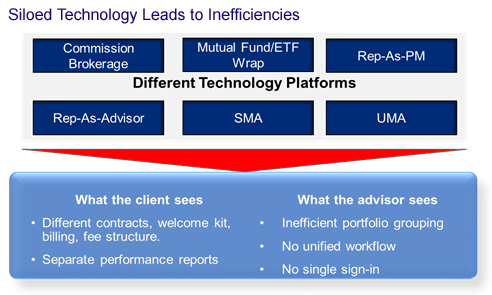Growing Efficient Advisory Programs Through Platform Consolidation
Developments in Managed Accounts
Abstract
Over the past 18 months, Celent has seen renewed interest among wealth managers in single infrastructure platforms.
In this report, Growing Efficient Advisory Programs Through Platform Consolidation: Developments in Managed Accounts, Celent explores the state of managed programs, the continuing barriers to efficient management of these programs, and how wealth managers are attempting to address these inefficiencies.
From a product perspective, single infrastructure platforms fold separately managed accounts (SMAs), mutual fund wrap, unified managed accounts (UMAs), rep-as-portfolio manager, and other programs into a common format. The platform serves as a chassis where advisors can open and select account structures, and the components and channel management tools sit atop.

“Despite decent growth in managed programs, one of the biggest barriers to greater adoption is inefficient management of product platforms,” says Alexander Camargo, Analyst with Celent’s Securities & Investments Group and author of the report. “The wealth platform will streamline fee schedules, contracts, welcome kits, and require only one signature. Most importantly, it will move services toward relationship-based pricing and client-centric models of service.”
This report begins with an overview of the managed accounts space, describing key drivers in the wealth management business. This is followed by an analysis of managed accounts, looking at growth in certain programs, and addressing why growth in the UMA and fee-based market has not been as robust as expected. It then examines the growth of platform consolidation so as to increase efficiency in managing a variety of products. This analysis includes business challenges solved, important tools in these platforms, and key challenges of this emerging model.

